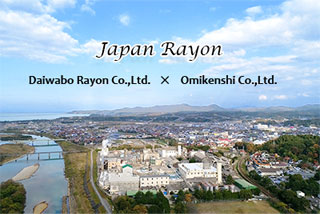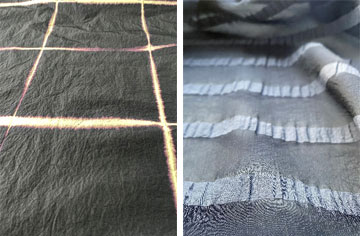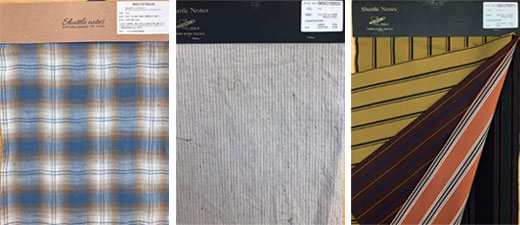


| AZEARTH CORPORATION / Leveraging materials in connection with DuPont |
AZEARTH CORPORATION, as a manufacturer of protective clothing, is set to make its debut at the Japan Pavilion at the Intertextile Shanghai event. The company, which owns local subsidiaries in Shanghai and Dalian, manufactures and sells raw materials and OEM/ODM products in Dalian and manufactures and sells raw materials in Shanghai. The Dalian subsidiary has previously participated twice in the domestic hall at Intertextile Shanghai. They acknowledge the China market as follows: ‘The market is awash with diversity, given the huge population and the speed at which all demands are met is simply astonishing and appealing. Conversely, it also causes problems, given the many differences in business systems, customs and product preferences compared to those in Japan.’ Although this will mark their initial appearance in the Japan Pavilion, they anticipate numerous visitors after joining the Japan Pavilion (Int’l Hall) compared to domestic participation and ‘hope to establish a platform to maximize negotiations’. As they normally focus on protective clothing, using materials provided by Du Pont, on this occasion, they will be showcasing products centring on value-added apparel-related materials, leveraging the business connection with Du Pont and a variation of ‘Nomex’; a flame-retardant material, which they are currently co-developing with Du Pont, plus heat module using carbon prints by Du Pont alongside other items using a module. |
 |
| KOWA COMPANY, LTD. / Outstanding feature of cotton as a raw material |
The company will participate in the Japan Pavilion for the first time, although they have local subsidiaries in Shanghai and Beijing. They see further potential in the China market and will join the show to target ‘cultivation of new customers’ on this occasion. They will be showcasing the following products: Ceaselessly developing ‘products with a unique twist such as hard-twist and compound products centring on cotton fabrics with unparalleled raw material.’ |
 |
| SUZUKI BLEACH & DYEING CO., LTD. / Providing finishing technique for anti-COVID-19 |
SUZUKI BLEACH & DYEING CO., LTD. a regular exhibitor at European textile shows, is set to make its Intertextile Shanghai debut this time. Although they have export records for China, given the inability to travel abroad due to COVID-19, they decided to participate in the show with the cooperation of a temporary local agent on this occasion. As a highly acclaimed finishing company in Japan, they make the fabrics of choice for numerous well-known European maisons. Items to be showcased include a gassed fabric using hard-twist yarns, which merits the A-class textile label. According to their comment; ‘Gassing is possible but making A-class textile with gassing treatment is quite difficult. But our unrivalled expertise in the preparatory phase is highly evaluated by European maisons.’ As well as refining their unrivalled functional finishing techniques, they will be showcasing textile treated to resist COVID-19, already in use for masks and other fashion clothing items in Japan and with certified functional efficiency. As for the sustainable fabric category, given their focus on natural fibres, they will be presenting finishing techniques to obtain unique and original textures via cotton, linen rayon and silk on this occasion. |
 |
| JAPAN RAYON (DAIWABO RAYON CO., LTD. / OMIKENSHI CO., LTD.) /Introducing Japanese rayon |
DAIWABO RAYON CO., LTD. will mark its first participation in an overseas exhibition at Intertextile Shanghai. Originally, two staple rayon manufacturers existed in Japan; DAIWABO RAYON and OMIKENSHI, but their competitor, OMIKENSHI, withdrew from the rayon manufacturing sector last year. DAIWABO RAYON will participate while leveraging the cooperation, insights and sales force of the local OMIKENSHI corporation. Commenting on their motivation, they said: ’We will make our appearance not as DAIWABO RAYON, but rather as a community of Japan rayon manufacturers. Although China has just as many rayon makers, we will promoting appealing our strong stand-out features unique to Japanese rayon makers. They explain that rayon is a sustainable fabric and will be showcasing products that reflect sustainability; rayon using recycled raw material and/or rayon that is globally certified in terms of safety and security. This participation represents their challenge to cultivate a new market, by fully leveraging the new collaborative relation with the previous competitor, for which motivation will be sky high. |
 |
| TAKU EDGE LLC / Promoting fabrics, planned in Bishu, produced in Hokuriku |
TAKU EDGE plans, designs and produces BISHU region textiles. Last September, they also participated in the Japan Zone, organised by Messe Frankfurt (HK), after the JFW Japan Pavilion was cancelled due to the pandemic. Although they received many visitors with many sample requests, it all ended there, as a result. Despite a wealth of experience exporting to Europe and the USA, it believes that local/onsite sales follow-ups will be necessary for business achievement and decided to participate in the show to increase their company recognition despite the difficult situation amid COVID-19. Their exhibits include: wool produced in the Bishu region, cupro and acetate fabrics manufactured in Hokuriku region cooperatives, plus fabrics such as Arimatsu shibori. Their collection will centre on Bishu ideas blended into the Hokuriku region, as their stand-out feature lies in development and reflects an in-depth understanding of production regions and their technicity. Consequently, their line-ups will feature sustainability-conscious fabrics. |
 |
| ASAHI FASTENER CO., LTD. / Appealing to the Chinese Vintage Market |
ASAHI FASTENER CO., LTD. comments; ‘Our <WALDES> brand has won increasingly widespread acclaim following our previous participation in Intertextile Shanghai and orders have been steadily growing, but we have also encountered imitation products like zipper pulls emerging in the local market and fully intend to promote our authentic products!’ The company remains confident about the Chinese market and has started engaging with local customers by establishing an office and showroom in Shanghai, paving the way for them to respond more swiftly to onsite demands and inquiries over prices and for product samples. They stick to producing zippers with cotton tapes, including those reproducing 1940s US military zippers, which will be showcased on this occasion. Their advantage is the ability to respond to small-batch offering wide-ranging variety and quick delivery service. They comment: ‘As the Chinese government is now promoting measures to expand domestic demand due to the pandemic and given the reported increase in the ratio of those classed as wealthy in the Chinese market, we anticipate a hike in demand for vintage market trends.’ |
 |
| IRIS CO., LTD. / Enhancing export to Chinese domestic apparel |
This occasion marks the fourth time this company will feature at the Intertextile Shanghai event via the Japan Pavilion. The company deals with accessories and values the China market and its further potential, explaining its decision to join again and target further exports to the Chinese domestic apparel market. They will be showcasing wide-ranging supporting materials in general; namely buttons, stoppers and various facemask parts, alongside sustainability-oriented products, decorative items and individual accessories. Their forte lies in the sheer abundance of variations; providing 7000 types (30,000 SKU). They have an integral system from production and stock control to sales, which allows them to sell products without specifying a minimum quantity. Moreover, they can manufacture products of equivalent quality at their own factories in Japan and China and leverage outstanding scope for development, announcing anything from 30 to 50 new items each year. Likewise, their accumulated export records to China and the availability of the local subsidiary also boost their achievement. |
 |
| UEYAMA ORIMONO CORP. / Anticipating EC brand visits |
UEYAMA ORIMONO CORP. is set to make its 3rd participation in the Japan Pavilion at this show. As well as being committed to developing yarn, the company is also able to control quality and delivery time, thanks to having its own factory facilities. Stand-out features include their unique yarns, unavailable elsewhere, such as OLD yarns spun with an ancient spinning machine as well as stocking raw yarns for organic cotton in multiple counts at their own risk. They have opened a local affiliate in China and anticipate visits from new EC brands. ‘The Chinese market is promising, while EC brands in particular show strong momentum,’ commented the company. They will be presenting a sustainable fabric range, including organic cotton and recycled nylon/cotton, alongside fabrics with surface variations such as seersucker, crepe and dobby. Alongside and abundant are bi/tri-blends based on natural fibres, cotton wool and cotton linen. |
 |
| KUWAMURA CO., LTD. / Showcasing products centring on eco-fabrics |
KUWAMURA CO., LTD. regularly exhibits at Intertextile Shanghai and maintains its presence this time around, retaining a local subsidiary in China and with a positive export record to date. ‘Given that the China market still has potential, we aim to acquire even more new customers.‘ Focal points of their range include eco-oriented fabrics, textiles with a special finish and wide-ranging counter samples. Their advantage is the feasibility to respond to the demand of fabric length starting from one roll or for making a sample piece. The company was founded in 1928 in the Nishiwaki area of Taka County in Hyogo Prefecture as a textile manufacturer, formerly producing textiles for export. After the war, they installed equipment for jacquard textiles and developed as a producer of yarn-dyed textiles. Later, in 2006, they established a subsidiary; Shanghai Kuwamura Co., Ltd. and have since concluded long-term business with China to date. The COVID-19 pandemic has forced the company to endure an extended period without exhibiting in Japan, which has raised expectations even more than usual for the show this time around. |
 |
| SOJITZ FASHION CO., LTD. / Potential Market for sales increase |
SOJITZ FASHION CO., LTD. will make its 8th appearance in the Japan Pavilion, Intertextile Shanghai this time, reflecting the notion that: ‘The Chinese market is in constant and hectic flux compared to Japan, which means the ability to weather such volatility could mean huge potential to expand business.’ The impact of the pandemic and travel restrictions has underlined the need for companies to procure fabric, while the online sales boom has helped shape an environment further optimised for stock operation, in their own words. Their initial aim is to remain in business with existing customers, while seeking opportunities to cultivate a new customer base through participation on this occasion. The company owns Sojitz Vancet (Shanghai) Trading Co., Ltd. as a Chinese corporation, via which it has exported to China to date. Exhibits include; Japanese-style prints featuring sensitive tonality and patterns originating from Japan, nylon-taffeta, retaining a cotton touch despite being synthetic, alongside T400; a contractile polyester with a nice surface-feel. They are a textile converter dealing with approx. 1200 product types in Japan and 150 or so in China, all of which handled via stock operation. They can also handle same-day shipping when stock is available. |
| SUNWELL CO., LTD. / Original planning - at the company’s own risk |
SUNWELL CO., LTD. founded SUNWELL (Shanghai) Trading Co., Ltd. in 2002 and has a long history of engagement with China. Indeed, they position China as ‘the only growing apparel market in the world’, which is why they participate regularly in the Japan Pavilion at Intertextile Shanghai and attract new customers every time. They are set to showcase fabrics that are both functional and have visual appeal. For example, highly chromogenic examples like triacetate, with a silky lustre, soft to the touch and with rich drapability, but as easy to care for as synthetics. Pride of place also goes to Product #52201S (Royal Light Satin Vintage), a semi-brushed satin, on the slim side with supple drapability and warm, velvety and lustrous to the feel. Product #11476S (60/2 union cloth; water-repellent gaberdine), a high-density and water-repellent gaberdine fabric of medium thickness; retaining a supple yet tensive texture and a stiff but also clear-surface feel. They will fully leverage their strengths: original planning and scope to handle products across the board at their own risk, to cope with even small-batch orders and those requiring quick delivery. |
 |